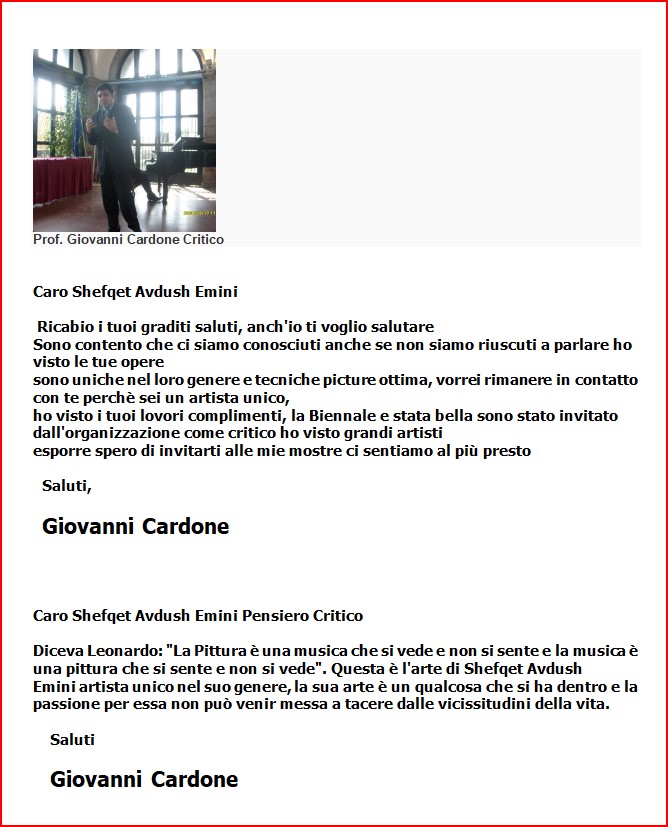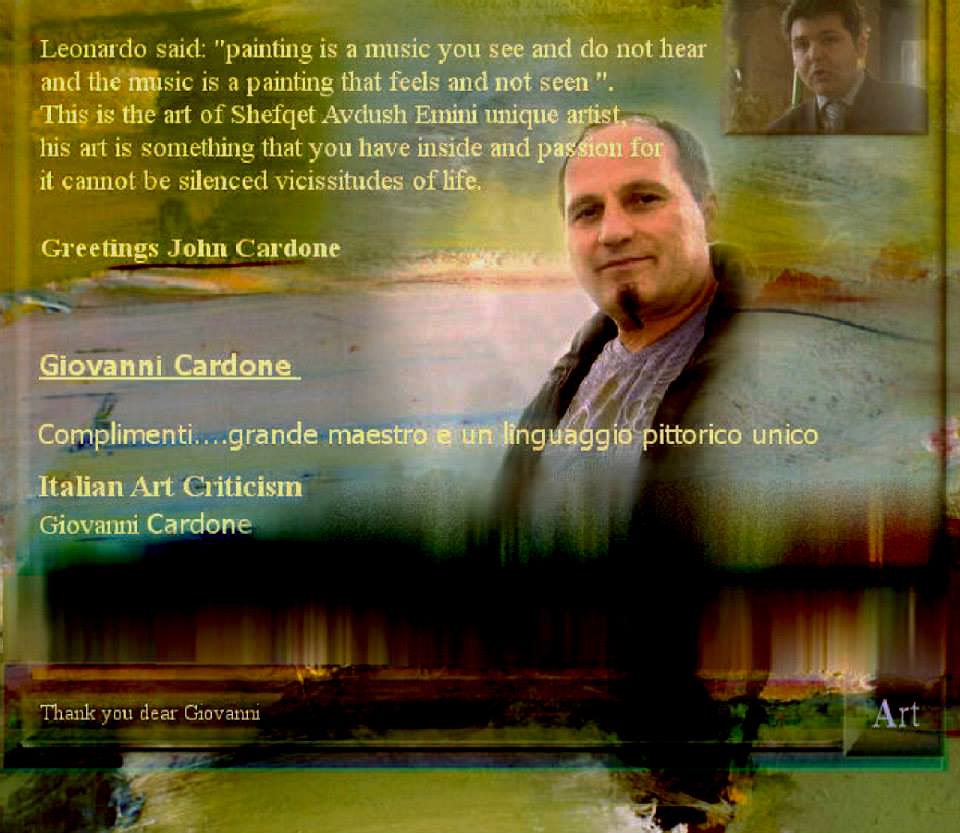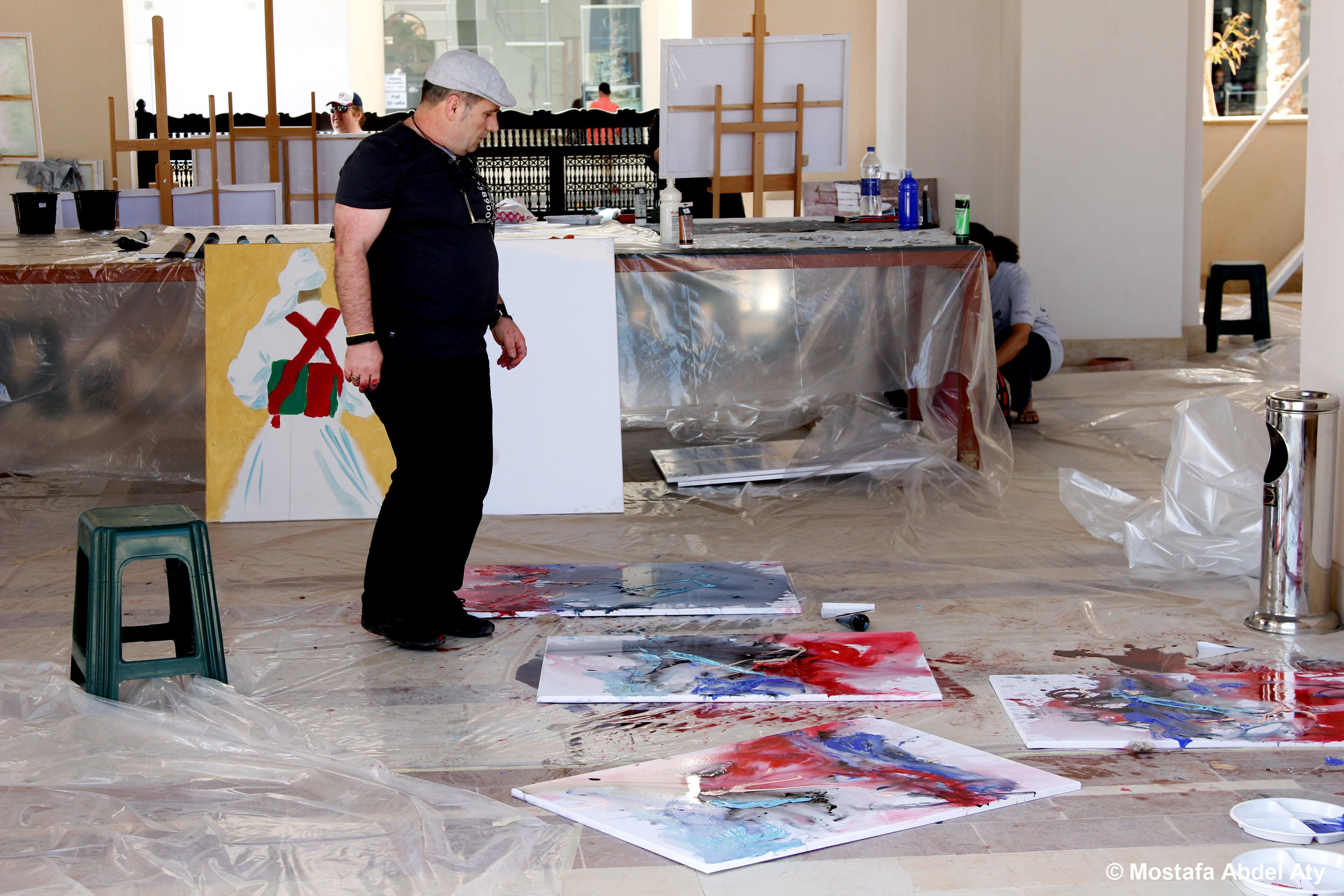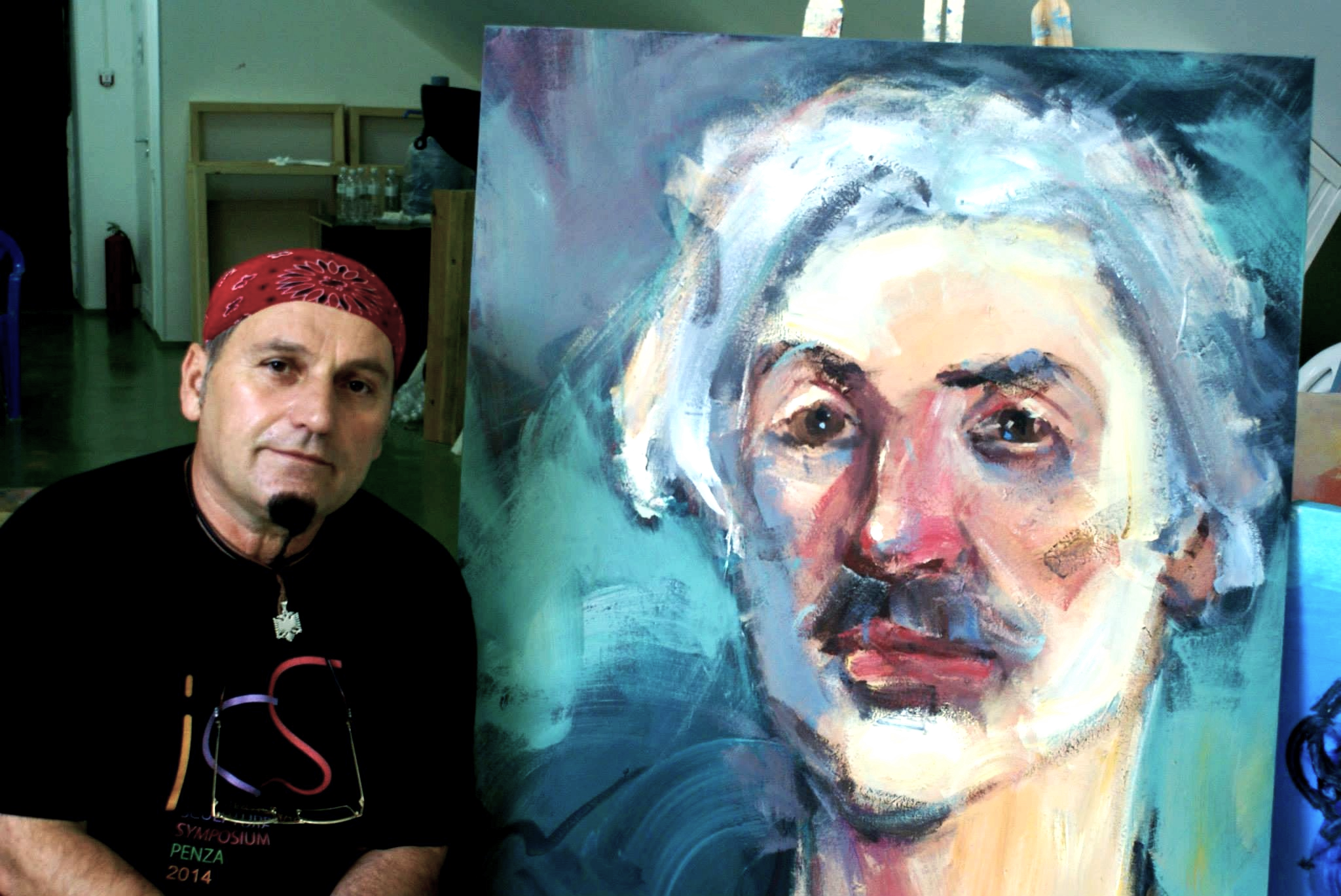Shefqet Avdush Emini – Një Emër i Madh i Artit Bashkëkohor Ndërkombëtar
Shefqet Avdush Emini është një prej figurave më të njohura të artit bashkëkohor në nivel ndërkombëtar, një artist që ka ndërtuar një karrierë të shkëlqyer dhe të admiruar në rrethet më prestigjioze të artit global. I lindur në Kosovë, Emini është pajisur me një talent të natyrshëm të jashtëzakonshëm, të cilin e ka zhvilluar dhe përkryer nëpërmjet një edukimi të thellë akademik në arte pamore, si dhe nëpërmjet një përvoje të gjatë krijuese që shtrihet në dekada.
Stili i tij i veçantë, që ndërthur ekspresionizmin dhe abstraksionin me një mjeshtëri të rrallë, është shndërruar në një gjuhë universale emocionale dhe vizuale. Pikturat e tij janë pasqyrime të fuqishme të ndjenjave njerëzore, të tensioneve shoqërore, të dhimbjes dhe shpresës, duke krijuar një komunikim të drejtpërdrejtë dhe të thellë me shikuesin. Çdo vepër e tij është një dialog i hapur mes përvojës personale dhe realitetit kolektiv, një univers ngjyrash që rrëfen histori të pashprehura me fjalë.
Prania në Skenën Ndërkombëtare të Artit
Shefqet Avdush Emini ka përfaqësuar me dinjitet dhe sukses artin shqiptar në shumë ekspozita, simpoziume dhe ngjarje ndërkombëtare në mbi 40 vende të botës, përfshirë: Suedinë, Danimarkën, Turqinë, Marokun, Egjiptin, Kinën, Austrinë, Holandën, Gjermaninë, Italinë, Mbretërinë e Bashkuar, Spanjën, Portugalinë, Francën (Luvri), Belgjikën, Rumaninë, Bullgarinë, Maqedoninë e Veriut, Kroacinë, Slloveninë, Serbinë, Bosnjën dhe Hercegovinën, Kosovën, Shqipërinë, Brazilin, SHBA-në, Kuvajtin, Sllovakinë, Poloninë, Omanin, Rusinë, Palestinën, Kanadanë, Algjerinë, Azerbajxhanin dhe Indinë.
Pjesëmarrja e tij e rregullt në simpoziume ndërkombëtare arti është dëshmi e rëndësisë që ai i kushton shkëmbimit krijues ndërkulturor. Aty ku krijon, ai gjithashtu frymëzon dhe ndan eksperiencën me artistë të tjerë nga mbarë bota, duke forcuar rolin e tij si një ndërlidhës kulturash dhe zë i rëndësishëm në dialogun global të artit bashkëkohor.
Koleksione të Përhershme dhe Ekspozita Ndërkombëtare
Punimet e tij ndodhen në koleksione të përhershme të disa prej institucioneve më prestigjioze të artit në botë, përfshirë:
Muzeu në Guwahati, Indi (2016)
Muzeu i Komunës në Pekin, Kinë (2015)
Muzeu i Komunës në Estrem, Portugali (2014)
Muzeu "Alija Izetbegović", Sarajevë (2013)
Muzeu i Artit Modern, Kuvajt (2012)
Muzeu MAC, Brazil (2011)
Galeria Tetovë, Maqedoni e Veriut (2010)
Galeria Aiud, Rumani (2010)
Muzeu Tepecik, Turqi (2010)
Galeria Aperon Art Plus, Stamboll (2010)
Galeria Tornby, Danimarkë (2010)
Galeria Kombëtare e Arteve, Tiranë (1999)
Shoqata figurative e artistëve të Kosovës (që nga 1989)
Pjesmarres i shume simpoziumeve, workshops, festivale Nderkombetare
Workshop of Nomad Canvases Çanakkale, Turqi 2024
Simpoziumi Ndërkombëtar i Artit në Trabzon,Turqi 2022
Ngjarje artistike në atelje Peter Hargas, Bratislavë, 2022
Simpoziumi Ndërkombëtar i Artit në Lehnice Sllovaki 2021
Simpoziumi Ndërkombëtar i Artit në Didim, Turqi 2020
Festivali Ndërkombëtar në Karadeniz Eregli, Turqi 2019
Arti ndërkombëtar femëror në Mus, Turqi 2019
Simpoziumi Ndërkombëtar i Artit në Trapzon, Turqi 2019
Arti ndërkombëtar femëror në Tunizi 2018
Simpoziumi ndërkombëtar i artit në Sllovaki 2018
Simpoziumi Ndërkombëtar i Artit në Tarsus, Turqi 2017
Simpoziumi Ndërkombëtar i Artit në Kushadasi, Turqi 2017
Kampi ndërkombëtar i artit Didim, Turqi 2016
Simpozium në Aydin, Turqi 2016
Simpoziumi i Arteve të Bukura në Indi Olympia 2016
Festivali në Baku, Azerbajxhan 2015
Simpozium në Hotel Kapari, Alacati, Turqi 2015
Simpozium në Setif, Algjeri 2015
Simpozium në Harram, Urfa, Turqi 2015
Simpozium në Antalia, Turqi 2014
Simpozium, Bolu, Turqi 2014
Simpozium në Beshiktash, Stamboll, Turqi 2014
Simpozium në Universitetin Özyeğin, Stamboll, Turqi 2014
Simpozium në Estremoz, Portugali 2014
Simpozium në Saguen, Quebec, Kanada 2014
Simpozium në Penza, Rusi 2014
Festivali Ndërkombëtar i Artit Gaza - Palestinë 2014
Simpozium në Stamboll, Turqi 2014
Artist in Residence, Kairo, Egjipt 2014 Workshop për punëtorët e Sindikatës Rinore – Ministria e Rinisë dhe Sportit Egjipt 2014
(II) Punëtori në Galerinë e Arteve të Freskos, Kajro, Egjipt 2014
(I) Punëtori në Galerinë e Arteve të Freskos, Kajro, Egjipt 2014
Simpozium në Sahl Hasheesh, Hurghada, Egjipt 2014
Simpozium në Sarajevë, Bosnje 2013
Simpozium në Penza, Rusi 2013
Plejada e artistëve ndërkombëtarë Prishtinë, Kosovë 2013
Simpoziumi Konia në Turqi 2013
Koloni artistike në Prishtinë, Kosovë 2013
Festivali në Sharm El Sheikh Egipt 2012
Simpoziumi në Birgi, Turqi 2012
Koloni arti në Izmir, Turqi 2012
Simpozium në Mojmirovce, Sllovaki 2012
Plejada e artisteve nderkombetare Prishtine,Kosovë 2012
Simpozium në Konia, Turqi 2012
Punëtori në Rembrandplein, Amsterdam The Netherland 1012
Simpoziumi në Kuvajt 2012
Festivali – VI Sharm Em Sheikh, Egjipt dhjetor 2011
Simpozium në Antalia, Turqi 2 qershor 2010
Festivali Ndërkombëtar i Arteve Gesha View – Bullgari mei 2011
Kolonia Tetov, Maqedoni qershor 2010
Simpoziumi Tepecik, Turqi qershor 2010
Simpozium Auid, Rumani, gusht 2010
Punëtori në Rembrandsplein, Amsterdam, The Netherlands 2010
Festivali në Sharm El Sheikh, Egjipt, prill 2010
Përkushtimi Akademik dhe Roli si Mentor
Përveçse është një piktor i njohur, Emini është edhe një edukator dhe mentor i përkushtuar. Në Holandë, ai është i lidhur me Akademinë Filarski, ku mban rregullisht ligjërata dhe masterklasa në pikturë, duke udhëhequr dhe formuar brezin e ri të artistëve. Puna e tij si edukator është një vazhdim natyral i misionit të tij artistik: të ndajë dije, frymëzim dhe përvojë, dhe të ndërtojë ura të qëndrueshme midis kulturave dhe brezave.
Pjesëmarrje në Ngjarje të Rëndësishme Artistike dhe Simpoziume
Për më shumë se tri dekada, Emini ka qenë pjesëmarrës i rëndësishëm në dhjetëra simpoziume ndërkombëtare arti në vende si Turqia, Sllovakia, Egjipti, Rusia, Algjeria, Palestina, India, Kanadaja, Kuvajti dhe të tjera. Disa nga më të rëndësishmet përfshijnë:
-
Çanakkale, Turqi – Workshop i Kanavacave Nomade (2024)
-
Trabzon, Turqi – Simpoziumi Ndërkombëtar i Artit (2022)
-
Bratislavë, Sllovaki – Aktivitet Artistik në studion e Peter Hargas (2022)
-
Lehnice, Sllovaki – Simpoziumi Ndërkombëtar (2021)
-
Didim, Turqi – Simpoziumi Ndërkombëtar (2020)
-
Gaza, Palestinë – Festivali Ndërkombëtar i Artit (2014)
-
Kajro, Egjipt – Rezidencë Artistike & Punëtori me Rininë (2014)
-
Sahl Hasheesh, Egjipt – Simpoziumi Ndërkombëtar (2014)
-
Saguenay, Kanada – Simpoziumi Ndërkombëtar (2014)
-
Penza, Rusi – Simpoziumi Ndërkombëtar (2013 & 2014)
-
Kuvajt – Simpoziumi Ndërkombëtar (2012)
-
Sharm El Sheikh, Egjipt – Festivale të shumta Ndërkombëtare të Artit (2010–2012)
Këto pjesëmarrje nuk reflektojnë vetëm suksesin artistik të tij, por edhe rolin e tij të vazhdueshëm si ambasador kulturor — duke afruar njerëzit dhe idetë përmes fuqisë së gjuhës pamore.
Stili Artistik dhe Filozofia Krijuese
Në zemër të artit të Shefqet Avdush Eminit qëndron një ndjeshmëri e thellë njerëzore dhe një përkushtim i fortë ndaj shprehjes autentike. Përmes vokabularit të ekspresionizmit të lirë dhe abstragimit emocional, ai ndërton botë vizuale që tejkalojnë kufijtë gjeografikë dhe kulturorë. Përdorimi i ngjyrës është i guximshëm dhe shpërthyes, ndërsa gjuha formale shpesh përfshin simbole dhe metafora vizuale.
Për Eminin, piktura është një akt emocional dhe filozofik — një udhëtim drejt thelbit të ekzistencës njerëzore dhe një reflektim mbi vuajtjen, shpresën, luftën, lirinë dhe dinjitetin. Ai nuk synon të përfaqësojë realitetin në mënyrë mimetike, por dëshiron të zbulojë shtresat e padukshme të shpirtit njerëzor. Kanavacat e tij janë të mbushura me një energji emocionale dhe shpirtërore që mbetet në mendje dhe në zemër.
Një Figurë Themelore në Historinë e Artit Bashkëkohor
Shefqet Avdush Emini është më shumë sesa një piktor i njohur — ai është një dëshmi e gjallë se arti ka fuqinë të ndërtojë ura, të shërojë, të ndërgjegjësojë dhe të kultivojë ndërgjegjen globale. Vepra e tij përballet me thellësitë e përvojës njerëzore dhe fton në reflektim të ndershëm përmes ngjyrës, formës dhe shpirtit krijues.
Në një botë gjithnjë e më shumë të përcaktuar nga ndryshimet e shpejta dhe konfliktet, arti i Eminit qëndron si një dritë e qëndrueshme — një gjuhë pamore e qëndrueshme që shpreh atë që fjalët shpesh nuk munden.
BOTIME – LIBRA, MONOGRAFI, ENCIKLOPEDI, ANTOLOGJI
2025 – Libri Kanavatet Kulturore të Arteve të Filipineve. Një Dialog mes Traditave të Artit Botëror dhe Filipinas 2023 – Libri Arti do të shpëtojë botën 2022 – Libri Arti i Filipineve dhe përtej
2021 – Enciklopedia e Artistëve Botërorë
2021 – Libri im i Parë i Artit
2021 – Libri im i Dytë i Artit
2021 – Libri im i Tretë i Artit
2021 – Antologjia e Tretë e Gogyoshi
2019 – Antologji Universale – Open Lane 4
2014 – Mjeshtrit Botëror – Bienalja Taza
2014 – Antologji Poezie 2014
2013 – Një Mësues që la Gjurmë në Arsim – autor Banush Imeri
2012 – Arti i Botës – autor Katerina Theofili
2010 – Gjenialiteti
2009 – Dega e Qethur Këndon për të Gjelbrën
2003 – Artium (libër-album)
1994 – Dritë në Lyrikum
MEDIA, VLERËSIME, ARTIKUJ, REVISTA
Periudha: 2021–2006 2021 – Shkrim nga Eriola Azizolli – Expres 2012 – Artikull kritik nga Erjola Azizolli – Expres
2012 – Faruk Tasholli – Gazeta Bota Sot
2012 – Shkrime për ekspozita ndërkombëtare në Oman – Expres
2010 – Vlerësim nga kritiku egjiptian Talaat Abdul Aziz
2010 – Vlerësim nga Remzi Limani
2008 – Artikull në Tirsdag, 29 janar
2006–2005 – Artikuj të shumtë në Bota Sot, Zëri, Lajmi, Epoka e Re
2005 – Artikuj në Hamburg Abendblatt, Hoheluftbrücke, Land van Weert, Trumpet
Periudha: 2003–1995 2003–1996 – Shkrime dhe vlerësime në: Koha Ditore, Fontys, Utrechts Nieuwsblad, Gazeta Limburger, Gazeta Rilindja, Zëri i Rinisë 1999 – Artikull në Gazeta Limburger
1997 – Broshurë kulturore Rondje
1996 – Broshurë profesionale kulturore (shkurt)
1996 – Program radiofonik i dedikuar artit
1996 – Artikull në Utrechts Nieuwsblad
1995 – Dy reportazhe televizive në TV2, Holandë
1990 – Artikull në Gazeta Rilindja
Periudha: 1987–1982 1987 (qershor) – Gazeta Rilindja 1983 – Gazeta Rilindja
1983 – Zëri i Rinisë
1982 (tetor) – Gazeta Rilindja
1982 – Zëri i Rinisë
INTERVISTA DHE EMISIONE TELEVIZIVE
2010 – Intervistë nga Michele Andree 2010 – Intervistë nga Natasha Gunn 1999 – Intervistë në transmetim ndërkombëtar televiziv
1996 & 1995 – Reportazhe televizive në TV2, Holandë
1996 – Program kulturor radiofonik i dedikuar artistit
Shefqet Avdush Emini – Kritika Ndërkombëtare dhe Vlerësime Artistike
Dr. Helmut Orpel – Gjermani Kritik arti, kurator dhe autor Vitet e veprimtarisë: 2018–2023
“Artisti Shefqet Avdush Emini është një zë autentik i artit bashkëkohor. Vepra e tij përfaqëson një shkrirje të shpirtërores dhe dramatikes, ku forma dhe ngjyra bëhen zëra të brendshëm të njerëzimit.”
Dr. Laura Thompson – Shtetet e Bashkuara Kritike arti dhe eseiste Rreth vitit 2020
“Arti i Shefqet Eminit është një eksplorim i thellë i psikikës njerëzore përmes një vizioni universal mbi dhimbjen, shpresën dhe kujtesën. Ai e vendos Kosovën në hartën e artit botëror.”
Prof. Giorgio Gregorio Grasso – Itali Kritik arti dhe kurator ndërkombëtar Vitet: 2020–2023
“Shefqet Emini është një artist me një identitet të fuqishëm vizual dhe shpirtëror. Veprat e tij janë emocionale, me një abstragim që flet me sinqeritet për njerëzimin.”
Dr. Yasser Elsheshtawy – Egjipt Kurator dhe studiues arti Vitet: 2022–2024
“Arti i Eminit është një mesazh universal i paqes dhe reflektimit njerëzor. Ai përfaqëson artin që nxit dialog mes kulturave.”
Ina Eskes, MA – Holandë Historiane arti Viti: 2011
“Shefqet Avdush Emini është një artist i njohur ndërkombëtarisht, një piktor me stil të veçantë, një ekspresionist i thellë që përcjell emocione të forta dhe mesazhe universale përmes ngjyrës dhe formës.”
Prof. Alexander Borovsky – Rusi Kritik arti dhe kurator në Muzeun Rus, Shën Petersburg Rreth vitit 2019
“Veprat e Eminit përcjellin një ndjenjë ekzistenciale dramatike. Ai flet për njeriun modern me një gjuhë që tejkalon kufijtë kombëtarë.”
Kim Young-ho – Koreja e Jugut Kurator dhe kritik arti Vitet: 2016–2018
“Artisti Emini sjell një botë të brendshme të mbushur me emocione. Ngjyrat e tij janë zëra të heshtur të historisë personale dhe kolektive.”
Zuzana Bartošová – Sllovaki Kuratore dhe kritike arti Viti: 2021
“Emini është një përfaqësues i artit ekspresionist pasluftës, ku ndjeshmëria e brendshme manifestohet përmes ngjyrës dhe lëvizjes.”
Dr. Fatima Zahra Lakrissa – Marok Historiane arti dhe kuratore Vitet: 2019–2023
“Artisti Emini ndërton ura mes Lindjes dhe Perëndimit me një gjuhë abstrakte që buron nga përvojat personale dhe kolektive të popullit të tij.”
Lista e Ekspozitave të Shefqet Avdush Emini
Vitet 2024 – 2020
-
2024 – Ekspozitë personale në Galerinë e Artit të Komunës Çanakkale, Turqi
-
2022 – Ekspozitë në Muzeun e Trabzonit, Turqi
-
2021 – Ekspozitë në Kalanë e Lehnicës, Sllovaki
-
2020 – Ekspozitë në Qendrën Kulturore, Ankara, Turqi
-
2020 – Ekspozitë në Hotelin Conrad, Stamboll, Turqi
2019
-
Galeria Ndërkombëtare e Arteve të Bukura Wiacamp, Galeria e Arteve – Eskisehir, Turqi
-
Art Hotel, Moskë, Rusi
-
Ekspozitë ndërkombëtare në hapësirë të hapur, Wiacamp, Didim, Turqi
-
Ekspozitë ndërkombëtare në Komunën Hol, Mus, Turqi
-
Ekspozitë ndërkombëtare në Karadeniz Eregli, Turqi
-
Galeria Antike, Trabzon, Turqi
-
Qendra Kulturore Vali Yazıcıoğlu, Aydin, Turqi
-
Qendra Kulturore Recep Yazicioglu, Aydin, Turqi
-
Galeria Hamam Çimeni Çarşısı, Trabzon, Turqi
2018
-
Galeria e Universitetit Gelisim, Stamboll, Turqi
-
Muzeu Terchova, Sllovaki
-
Kaptan Hotel, Alanya, Turqi
-
Shtëpitë e Kulturës, Tunizi
-
Galeria e Arteve Dramalılar Köşkü, Bornova, Izmir, Turqi
-
Wiacamp, ekspozitë në ambient të hapur, Kuşadası, Turqi
-
Muzeu Gural, Kapadokya, Turqi
-
Castel, Sllovaki
-
Galeria e Bashkisë Bursa Nilüfer, Turqi
-
Qendra e Kulturës dhe Artit Hall Hanam, Kore e Jugut
-
Galeria Turhan, Denizli, Turqi
-
Galeria e Artit Kuzey & Bahar, Stamboll, Turqi
-
Qendra Kulturore e Komunës Epinay, Paris, Francë
2017
-
Galeria e Arteve Emin Serdar, Trabzon, Turqi
-
Qendra Kulturore Atatürk, Universiteti EGE, Izmir, Turqi
-
Bashkia Beylikdüzü – Beylicium Shopping Center, Stamboll, Turqi
-
Galeria Sarayı, Mersin, Turqi
-
Galeria e Arteve Doku, Stamboll, Turqi
-
Muzeu Povazske, Sllovaki
-
Galeria Ibramaki, Kuşadası, Turqi
-
Muzeu Konak, Izmir, Turqi
-
Salla e Artit Al-Pyramids, Kairo, Egjipt
-
Muzeu Corvins’ Castle, Hunedoara, Rumani
-
Qendra Kulturore Leczna, Poloni
-
Galeria Bal Art, Tarsus, Turqi
-
Galeria e Arteve Carina, Kuşadası, Turqi
-
Galeria e Arteve Yolo, Kuşadası, Turqi
-
Qendra Kulturore Hamamizade İhsan Bey, Trabzon, Turqi
2016
-
Universiteti Adnan Menderes, Didim, Turqi
-
Galeria ATSO Kurumsal Bahçesi, Antalya, Turqi
-
Ambient i hapur, Didim, Turqi
-
Biblioteka Kombëtare e Rumanisë, Bukuresht
-
Qendra Kulturore për Arte, Aydin, Turqi
-
Muzeu Guwahati, Indi
2015
-
Muzeu i Pekinit, Kinë
-
Muzeu i Bakusë, Azerbajxhan
-
Hotel Kapari, Alacati, Turqi
-
Galeria në Setif, Algjeri
-
Hotel Harram Kumbert, Urfa, Turqi
-
"Inter-Art" – Gjenevë, Zvicër
2014
-
Bienalja Taza, Marok
-
Qendra Kulturore Erdem Bayazit, Antalya, Turqi
-
Galeria Kultur Sitesi Salonu, Bolu, Turqi
-
Galeria Mustafa Kemal Merkez, Stamboll
-
Ambient i hapur në Apeldoorn, Holandë
-
Art-Penza – Festivali i Artit Bashkëkohor Çernozem, Rusi
-
Muzeu Historik Kombëtar i Transilvanisë, Cluj-Napoca, Rumani
-
Muzeu Komunal, Estremoz, Portugali
-
Qendrat e Kulturës Saguen, Quebec, Kanada
-
Galeria e Arteve Penza, Rusi
-
Gaza, Palestinë
-
Universiteti Özyeğin, Stamboll, Turqi
-
Tipsy Teapot, Kajro, Egjipt
-
Gurin, Francë
-
Villa 43 Maadi Sarayat, Egjipt
-
Tutin, Shtëpia e Kulturës, Serbi
-
Restorant Guri, Kajro, Egjipt
-
Galeria Priboj Spiral, Serbi
-
Hotel Renaissance, Kajro, Egjipt
-
Prijepole, Shtëpia e Kulturës, Serbi
-
Galeria Roman Petrovic, Sarajevë, Bosnje
-
Plavë, Shtëpia e Kulturës, Mali i Zi
-
Sahl Hasheesh, Hurghada, Egjipt
-
Pirot, Shtëpia e Kulturës, Serbi






